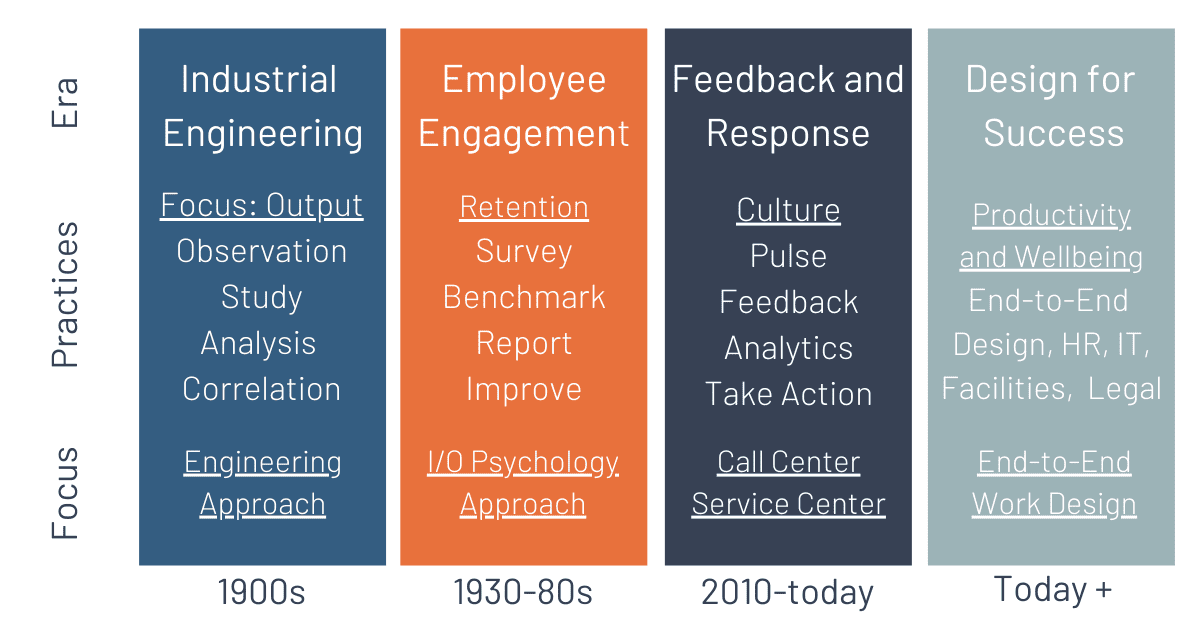Employee Experience (EX) is not a new concept. Nor is it the latest ‘trend’. Organizations have always recognized the impact on productivity and success. In fact, we can trace the development of EX as a business concern right back to the 1900’s – a far cry from EX as we know it today. When we consider the evolution of the workplace, it’s no surprise that we’ve seen a shift in organizational priorities and a move away from utility toward employee sentiment; we’ve transitioned from a focus on employee’s physical work experiences to their digital ones.
The evolution of employee experience
We’ve spoken before about how Digital Employee Experience (DEX) is the priority for organizations keen to remain productive in the modern workplace, but how did we get here? What came before and how has it shaped EX as we know it today?
Josh Bersin, President and Founder of industry research and advisory firm, Bersin & Associates, traces the roots of Employee Experience through four key eras:

We can see that the core roots of EX started with ‘Industrial Engineering’ and a focus on output. This meant figuring out the physical and environmental factors to improve productivity, safety, and quality at work. Research by mechanical engineer, Fredrik Taylor, into the behavior of steelworkers uncovered the optimal working conditions to ensure productivity. E.g., If workers carried over the optimum load of 50lbs, risk of fatigue and injury increased and, consequentially, productivity took a hit.
Next came ‘Employee Engagement’ and the focus on retention. This phase saw the introduction of employee surveys, saw the likes of Gallup create “Engagement Models” to predict employee outcomes, and vendors such as Kenexa sell benchmarking data, survey tools, and consultancy services.
The third phase is ‘Feedback and Response’ that focused on culture, and the need to ‘design’ a better experience at work. This was the world of “pulse surveys” where employees were encouraged to give feedback and the doors to sentiment analysis were opened. It’s worth noting here that the data businesses were able to collect held significant power – one of the largest Utilities in the US found employee feedback about maintenance issues which later predicted a massive fire.
This brings us to today, where EX is all about an integrated experience, the move from passive to active, and a core focus on productivity and wellbeing. However, the pandemic-accelerated move to remote and hybrid working created a reliance on the digital world. It impacted what ‘employee experience’ looks like and what organizations need to do to provide a great one. Employees have traded the physical office for a virtual one. Digital devices have become the primary connection point between organization and individual in many instances. And so, Digital Employee Experience and the requirement for DEX programs and practices was born.
But why does employee experience matter?
It’s clear that EX has always had an important place when it comes to business priorities. But why?
The answer is simple. A poor employee experience transcends potentially getting some bad Glassdoor or Google reviews. It can have a noticeable impact on the business bottom line! A positive or negative employee experience affects business performance. Let’s break this down…
Put simply, happy employees = better employee retention, less attrition, lower costs and – by extension – better customer experience. A poor employee experience equates to dissatisfaction, disengagement, and lost productivity – which can ultimately be very costly. There’s no shortage of research in this area, that highlights just exactly what this looks like.
For example,
- Revenue: The less productive employees are, the more your revenue is impacted. A Hubspot report found that lost productivity costs US businesses $1.8 trillion dollars each year. It’s safe to say then, that improving employee engagement and prioritizing staff engagement and productivity are essential initiatives for any organization keen to improve revenue.
- Turnover: Failure to provide a good EX means staff are dissatisfied and more likely to move on, leaving the business to face the financial and time cost of replacement. It is estimated that the average cost to replace employees are: $1,500 for hourly employees, 100-150% of a technical employee’s salary, and up to 213% of a c-suite position. Businesses that ensure employees have good digital experience will see an increase in staff retention.
- Customer experience (CX): This is an easy one, happy employees = happy customers. As Forbes explains, 79%of employees at companies with above-average CX are highly engaged in their jobs, and companies that invest in employee experience are 4X more profitable. To improve the employee experience is to, by extension, improve the customer experience.
Well, there you have it – the benefits of employee engagement are evident! And in the current modern hybrid workplace, it is vital for organizations to prioritize providing an excellent digital employee experience to keep employees engaged, productive, and contributing to the business bottom line.
If you want to learn more about digital employee experience why not take a look at Forrester's DEX Report here. It's full if interesting insights and reveals why organizations with more mature DEX programs are headed for success!








